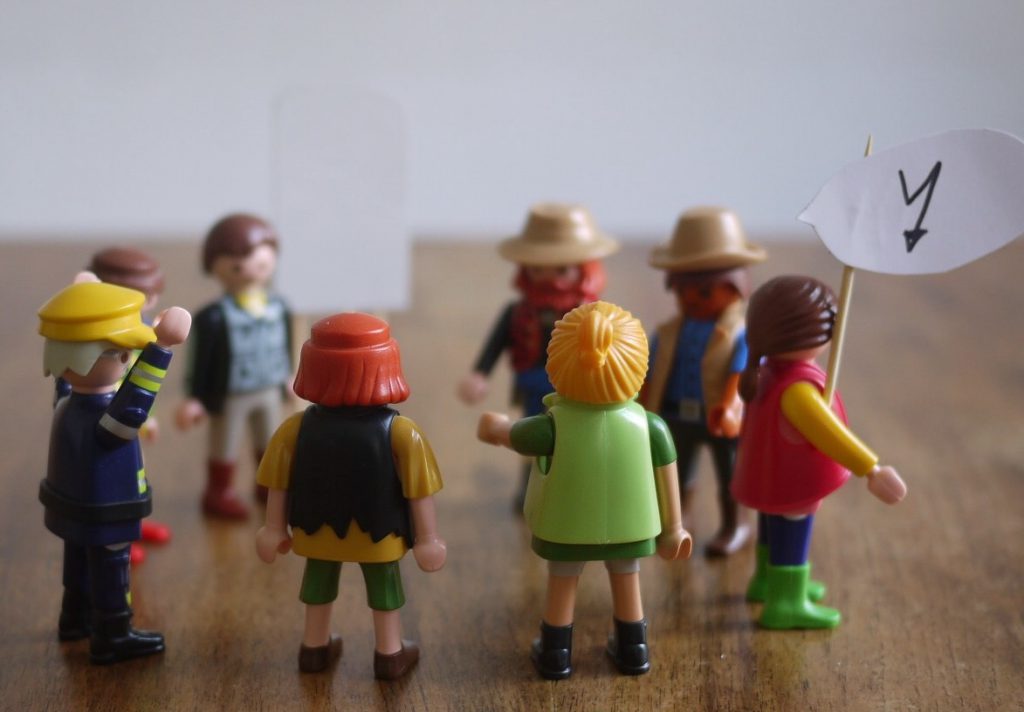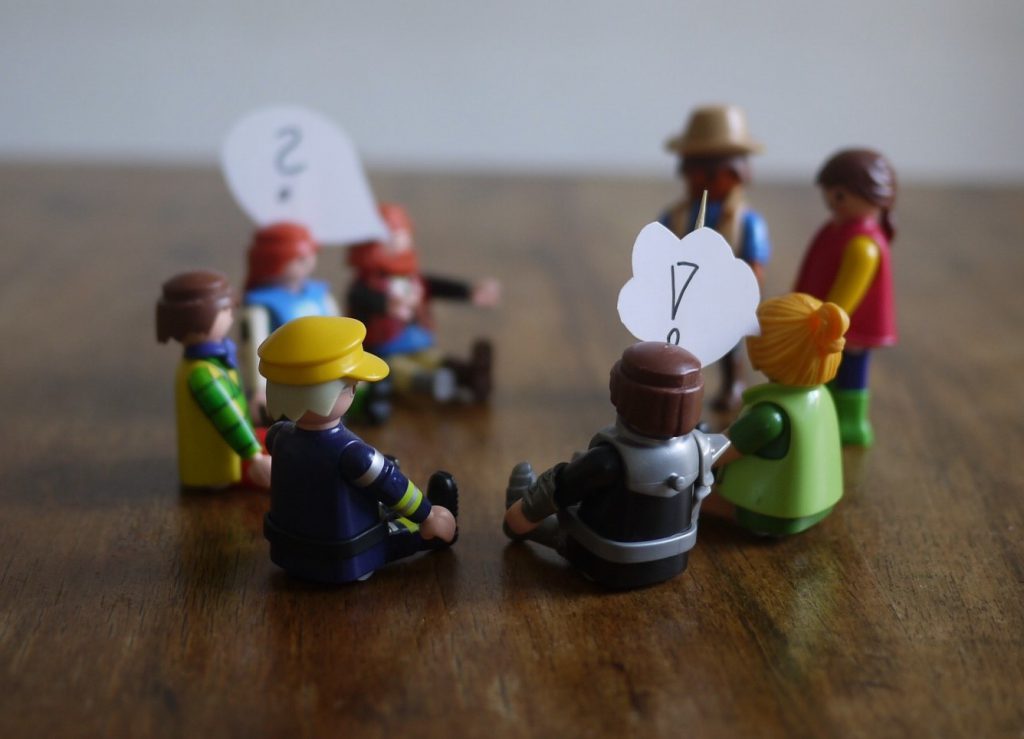This time we’re going to let it rip! That’s right, it’s about conflicts in the group. What do I do when everyone is arguing? What is a conflict and how do I deal with it as a group leader or facilitator? Is a conflict always loud? And what do I do when there is no solution?
A conflict is a difference of interests that are in conflict with each other. For example, I would like to eat ice cream, but I don’t want sweets. That can lead to an inner conflict. Or someone wants to live in the country, but most of the family members want to live in the city.
Let’s try something smaller: I have a seminar group and want to agree on a time for lunch. I set the framework: At least one hour, at most one and a half hours. The end of the seminar day depends on the duration of the lunch break. It’s a classic! A third of the participants are for one, a third for the other and the rest don’t care or no – for the rest both are okay. But where are the others? Don’t worry, our five experts on everything to do with groups will be on the scene in a moment. Of course, they also have a wide range of experience with conflicts in groups, and also in constellations where they themselves were parties to the conflict.
Meeting in the restaurant garden
„I love conflicts!“ sighs Yasemine, in response to Rudi’s dewy-eyed anecdote from the tram. „Unless, of course, I’m a party to it. I find that less ‚interesting‘.“ She and Rudi are already there and a little nervous. After all, it’s the first time they’ve been in a restaurant in weeks – the relaxed regulations and Maria’s absence, otherwise there would be too many of them, make it possible. There is little going on in the restaurant garden, huge, unopened sunshades stand as spacers between the tables and the guests.
In the next few minutes, Beate and Paul arrive. The latter is just finishing a phone call. The other three don’t understand what the conversation was about, but they do understand that it was unpleasant and emotional, despite their lack of knowledge of Polish. „This can’t be happening! My mother insists on my visit and just ignores the current border regulations. She acts as if I don’t want to and doesn’t want to understand that it’s not possible right now!“, Paul says, still agitated by the phone call. The three colleagues recognise the situation immediately and intuitively decide to give the problem space, because an exchange on another topic does not seem possible anyway as long as Paul is so agitated.
Questions and perspectives
True to the motto ‚disturbances have priority‚, the three accompany Paul through the situation. Questions are asked and different perspectives are taken. After about half an hour, Paul is one step further. He decides to discuss the situation in more detail with his mother via video telephony – with technical support from Paul’s cousin – and to see together how they can reconcile their needs. Paul is currently allowed to enter the country as a relative, but he fears that he would have to go into quarantine after returning to Austria, which he cannot imagine at the moment. In any case, the collegial counselling did him good and helped Paul to differentiate the situation and to find out what it could actually be about. It also occurred to Paul that it would be good to look at some theory on the subject again, such as Friedrich Glasl and his escalation stages in conflicts, which help with orientation in corresponding situations and also give suggestions for dealing with them.
A problem is a description
„Actually, we are already in the middle of the topic anyway,“ Beate says, reminding us that this time the group wanted to talk about dealing with conflicts. The others think so too and are once again touched by the realisation of what a good resource they and their meetings are for each other. „I think that in your situation, Paul, it became very clear what a problem actually is, namely the description of a situation.“
„For many situations, there are as many descriptions as there are people involved, and conflicts can arise from that,“ Rudi admits. In response to Paul’s question about what he meant, Rudi continues: „I understood it to mean that your mother is offended or grumpy because you don’t want to visit her, even though the current regulations would allow it and you have more free time than usual right now.“ „Yes, and more than I would like,“ Paul quickly interjects before Rudi elaborates: „I understand from you that while you would like to see your mother again, you consider the risk of quarantine after your return too great, and it is important for you to be able to react flexibly to changes, for example to be available again as a training course coach as soon as regulations allow. Here it’s easy to see that you describe the problem very differently and it might be helpful to bring your perspectives closer together.“ Paul now understands, „That’s totally true because it’s a very different starting point than accusing me of not wanting to.“
Addressing it and giving space
Yasemine finds that such an approach is quite often helpful in conflict situations. Ideally, there are also people who are not involved and who can support the conflict parties in bringing in other perspectives or at least listen to the different descriptions of the problem. „Of course, it is important to define the problem in advance, because very often we think it is clear what is wrong anyway, because bad moods or discomfort are noticeable. I have also experienced this with groups many times,“ Yasemine says. „And what do you do then?“ asks Beate, who is also familiar with such situations, but sees them more as a disturbance than a challenge.
„If I have the impression that the atmosphere is tense, but I don’t know exactly what it’s about, then I sometimes make it transparent and ask the group or address the mood and my irritation. Often a space for discussion opens up where conflicts can be resolved or a way of dealing with them can be found.“ Beate is sceptical and says: „Yes, and then there are the participants who really like it and who also like to have emotional or heated discussions, and those who don’t care or who want to stay out of it, and they feel they have been robbed of valuable time. I also know this from myself as a participant.“
Conflict management needs structure
„You just have to agree on something,“ Rudi interjects, and says that in such a situation it is important to agree on how to proceed before moving on in conflict transformation. „I suggest, for example, that we give the issue time until the break and then see how everyone is doing and whether they are able to work again or whether they still need something. I have also divided the group and stayed with those who were involved or affected by the conflict and the others dealt with another topic. That worked well! It is important to bring the sub-groups together again, possibly to report to each other, and to get a picture of the mood again,“ Rudi continues. „Personally, I also think that any processing, or even just addressing, is better than ignoring the open or latent conflict.„
„But I also know that such an attitude is not right for everyone. It makes sense for group leaders to act in a way that suits their professional attitude,“ Yasemine adds. With a sigh of relief, Beate rejoins the discussion: „I’m really glad that you said that, Yasemine, because I’m not so good at dealing with conflicts in the group and I just find it annoying. At the same time, while listening, I also noticed that your approaches somehow make the topic of conflicts seem more differentiated to me. I think that enables me to have another discussion, where it might not be a bad idea to take a closer look. „Problem description“ and „different interests“ somehow sound less bad and exhausting than „conflict“. Thanks for that!“
And now?
But now once again back to the beginning: What do I do now with the group that is supposed to decide how long their lunch break should be? Often, all it takes is a little time in which the group itself has the opportunity to find a solution. For this, it is necessary to know each other’s different positions. As a facilitator or trainer, my only task is to make this possible.
Ideally, the group has a sense of achievement because it succeeds in coming to a joint decision despite different wishes. If I observe that more support would be helpful, I can ask for tools that the participants have already used in similar cases or suggest appropriate methods. The simplest and quickest method is probably voting. It is important to keep in mind that a vote does not leave much room for individual needs or arguments, and it is important to clarify in advance what majority makes a decision valid. If needs and arguments are to have room and yet a vote is desired, time can be given beforehand for discussion or for a round where each individual has the opportunity to say something. An interesting method is ‚systemic consensus‚, where not the wishes, but the resistance to the scenarios available for selection is asked for. The concept of non-violent communication has also proven to be extremely helpful for taking stock of conflicts, needs and wishes, if – and this applies to all methods and tools – it fits one’s own professional identity.
At their next meeting, Maria, Paul, Yasemin, Rudi and Beate will deal with diversity in groups and look forward to your interest!
Authors: Gerda Kolb and Irene Zavarsky
Lust auf mehr? Zu allen Beiträgen der Serie kommst du HIER!

Dieses Werk ist lizenziert unter einer Creative Commons Namensnennung-NichtKommerziell-Weitergabe unter gleichen Bedingungen unter gleichen Bedingungen 3.0 Österreich Lizenz.
Volltext der Lizenz




